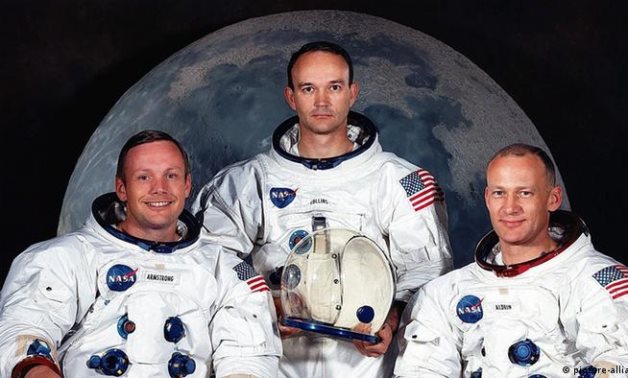
The Apollo 11 crew - US astronauts Neil Armstrong (left), Michael Collins (center), and Edwin 'Buzz' Aldrin (right) - Picture-Alliance/dp
CAIRO – 20 July 2022: At 10:56 pm on July 20, 1969, 240,000 miles from Earth, Neil Armstrong became the first American astronaut to walk on the moon.
Prior to this day in 1966, after 5 years of work by an international team of scientists and engineers, the National Aeronautics and Space Administration [NASA] conducted the first unmanned Apollo mission to test the structural integrity of a proposed launch vehicle and spacecraft assembly.
On January 27, 1967, a tragedy occurred at the Kennedy Space Center in Cape Canaveral, Florida, when a fire broke out while testing the manned launch pad of the Apollo spacecraft and the Saturn rocket. Three astronauts were killed in the fire, according to History.
In October 1968, Apollo 7, the first manned Apollo mission, orbited the Earth and successfully tested many of the complex systems needed to make the trip to the moon and land.
In December of the same year, Apollo 8 took three astronauts to the far side of the moon and orbited it 10 times before returning. In March 1969, Apollo 9 tested the lunar module for the first time while in Earth’s orbit.
Then in May, the three Apollo 10 astronauts took the first complete Apollo spacecraft in 31 orbits around the moon on a dry run for the landing mission scheduled for July.
At 9:32 am on July 16, with the world watching, Apollo 11 took off from the Kennedy Space Center carrying astronauts Neil Armstrong, Edwin Aldrin Jr., and Michael Collins. Armstrong, a 38-year-old research pilot, was the mission leader.
After traveling 240,000 miles in 76 hours, Apollo 11 entered lunar orbit on July 19. The next day, at 1:46 pm, the Eagle lunar module operated by Armstrong and Aldrin detached from the command module, with Collins remaining two hours later.
The Eagle began its descent to the moon's surface, and at 4:18 pm, the craft landed on the southern edge. At 10:39 pm, 5 hours earlier than originally scheduled, Armstrong opened the lunar module hatch. As he made his way down the lunar module’s ladder, a television camera attached to the craft recorded his progress and sent the signal back to Earth, where hundreds of millions watched with great anticipation. At 10:56 pm, he planted his left foot on a soft, gray surface, took a cautious step forward, and humanity walked on the moon.
Comments
Leave a Comment